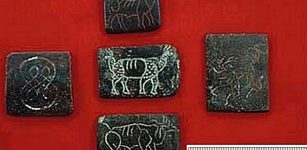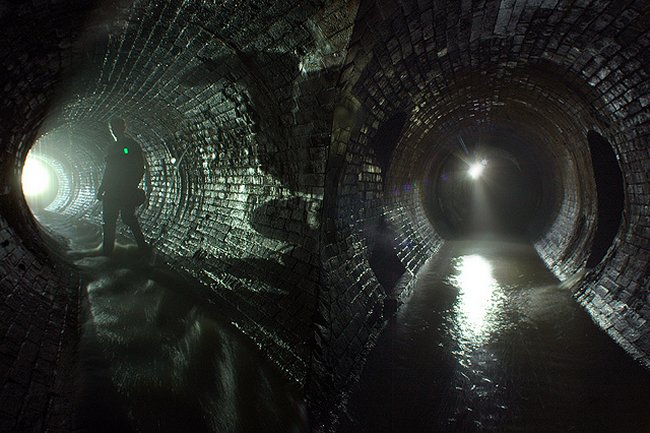London’s Underground Rivers Were Deliberately Hidden
Ellen Lloyd - AncientPages.com - When you think of London, many things come to mind, but not the fact that many hidden underground rivers flow beneath the significant capital of the UK.
Traces of London's lost rivers are visible throughout the city, if you know what to look for Photo: SF Said
Below the ground is a vast network of tunnels and chambers, put in place by Victorian engineers, the final step in a process which took centuries.
London once needed all the rivers it could get: for drinking water, for harbors and wharves, for mills, for tanneries, and for sluicing away waste. The rivers were London's sewage system long before any system was built. Still, even tiny medieval London was too much for any stream to cope with, and many inner London waterways remained deliberately hidden.
The Fleet is probably one of the better-known rivers located beneath Londoners' feet.
Vestiges of it can be traced above ground by following a modest stream that flows from Hampstead and Highgate Ponds in north London.
 The Victorian brickwork from Joseph Bazalgette's sewer system remains in a preserved state. Image credit: Emma Lynch BBC
The Victorian brickwork from Joseph Bazalgette's sewer system remains in a preserved state. Image credit: Emma Lynch BBC
Today it is swiftly submerged, becoming a sewer that flows to Blackfriars Bridge on the River Thames.
During Medieval times the waters of the Fleet were renowned for being clean.
As London city grew, mills, tanneries, and meat markets appeared along its banks. Water was vital to keep these industries functioning and growing.
Gradually, however, the river was polluted with blood, sewage, and other waste, so it became a waste tip, an easily accessible repository to discard anything unwanted, including the carcasses of dead livestock.
Image Credit Flickr User sub-urban.com
London's origins are deep in the Walbrook, the river around which the Romans founded the city. The debris dug from the river – hoes and plow shares, chisels and saws, scalpels and spatulas, the heads of forgotten gods, and a collection of 48 human skulls tell the earliest London tales.
As a result, over the years, the river became shallower and the water much slower than in previous generations, only exacerbating the burgeoning problem of the health hazard it now presented. It would silt up in the summer, and although the spas and wells upstream remained open and functioning, the Fleet in London became an open sewer with a mix of slums and prisons on its banks. Something had to be done.
 The Walbrook's name derives from the fact the brook passed by the Roman city's wall. Image credit: Alan Sorrell/Museum of London
The Walbrook's name derives from the fact the brook passed by the Roman city's wall. Image credit: Alan Sorrell/Museum of London
A solution was urgently needed. The architect Sir Christopher Wren was afforded the chance of transforming the lower Fleet. The Great Fire of London in 1666 provided that opportunity.
The river was channeled underground in the 1730s from Holborn to Fleet Street, which still bears its name. Decades later, it was filled in and arched over from Fleet Street down to the river Thames and is covered by what is now New Bridge Street.
Perhaps, the rivers are hidden, but they are far from gone. It is tough to stop a river from flowing, so they have merely been diverted into the sewer system.
Written by - Ellen Lloyd – AncientPages.com
Copyright © AncientPages.com All rights reserved. This material may not be published, broadcast, rewritten or redistributed in whole or part without the express written permission of AncientPages.com
Expand for referencesMore From Ancient Pages
-
 Mysterious Ancient Star-Shaped ‘Fossil’ Baffles Scientists – What Is It?
Archaeology | Feb 27, 2023
Mysterious Ancient Star-Shaped ‘Fossil’ Baffles Scientists – What Is It?
Archaeology | Feb 27, 2023 -
 Ah Puch: Evil Death God Of Underworld Who Hated Souls In Maya Beliefs
Featured Stories | Feb 16, 2018
Ah Puch: Evil Death God Of Underworld Who Hated Souls In Maya Beliefs
Featured Stories | Feb 16, 2018 -
 Polish Excavations At Tell el-Murra And Long History Of Egyptian Coffins
Archaeology | Apr 6, 2018
Polish Excavations At Tell el-Murra And Long History Of Egyptian Coffins
Archaeology | Apr 6, 2018 -
 Mysterious Secret ‘Square’ Discovered Beneath Avebury Stone Circle
Archaeology | Jun 30, 2017
Mysterious Secret ‘Square’ Discovered Beneath Avebury Stone Circle
Archaeology | Jun 30, 2017 -
 Pena Molexa (Lunar Boat): Megalithic Corner Dedicated To A Magician Woman Who Knows The Secrets Of Earth And Underworld
Featured Stories | Jul 23, 2023
Pena Molexa (Lunar Boat): Megalithic Corner Dedicated To A Magician Woman Who Knows The Secrets Of Earth And Underworld
Featured Stories | Jul 23, 2023 -
 Gungnir: Odin’s Magical Weapon That Provoked Or Reduced Conflicts In Norse Mythology
Featured Stories | May 12, 2020
Gungnir: Odin’s Magical Weapon That Provoked Or Reduced Conflicts In Norse Mythology
Featured Stories | May 12, 2020 -
 Mythical Shield-Maidens Did Exist – Evidence Of Female Viking Warriors Discovered
Archaeology | Sep 9, 2017
Mythical Shield-Maidens Did Exist – Evidence Of Female Viking Warriors Discovered
Archaeology | Sep 9, 2017 -
 Mysterious People Who Appeared Out Of Nowhere
Featured Stories | Sep 1, 2018
Mysterious People Who Appeared Out Of Nowhere
Featured Stories | Sep 1, 2018 -
 Curious Ancient Copper Plates And The Mystery Of Indus Valley
Artifacts | Oct 24, 2015
Curious Ancient Copper Plates And The Mystery Of Indus Valley
Artifacts | Oct 24, 2015 -
 Evidence Of Neolithic Bird Hunting In Upper Mesopotamia
Archaeology | Sep 27, 2023
Evidence Of Neolithic Bird Hunting In Upper Mesopotamia
Archaeology | Sep 27, 2023 -
 Knowledge Of Ancient Medicine Hidden In Undeciphered Egyptian Manuscripts
Archaeology | Aug 16, 2018
Knowledge Of Ancient Medicine Hidden In Undeciphered Egyptian Manuscripts
Archaeology | Aug 16, 2018 -
 19 Cannons Shot From British Ships During The American Revolution Discovered In Savannah River
Archaeology | Apr 29, 2022
19 Cannons Shot From British Ships During The American Revolution Discovered In Savannah River
Archaeology | Apr 29, 2022 -
 Ahimsa – Ancient Non-Violence Concept Teaching Compassion And Love Towards All Living Beings
Featured Stories | Jan 2, 2019
Ahimsa – Ancient Non-Violence Concept Teaching Compassion And Love Towards All Living Beings
Featured Stories | Jan 2, 2019 -
 Amakuni – Legendary Japanese Blacksmith And Father Of The Samurai Sword
Featured Stories | Jan 23, 2019
Amakuni – Legendary Japanese Blacksmith And Father Of The Samurai Sword
Featured Stories | Jan 23, 2019 -
 Silver Coins Hidden In Chess Figure Date Back To Ivan The Terrible’s Days – Discovery In Moscow
Archaeology | May 13, 2017
Silver Coins Hidden In Chess Figure Date Back To Ivan The Terrible’s Days – Discovery In Moscow
Archaeology | May 13, 2017 -
 Something Surprising Happened With Temperature Since The Start Of The Holocene – New Study
Archaeology | Oct 10, 2022
Something Surprising Happened With Temperature Since The Start Of The Holocene – New Study
Archaeology | Oct 10, 2022 -
 Coronavirus: Advice From The Middle Ages For How To Cope With Self-Isolation
Featured Stories | Mar 29, 2020
Coronavirus: Advice From The Middle Ages For How To Cope With Self-Isolation
Featured Stories | Mar 29, 2020 -
 Rare Gold Coins And Treasures Linked To Crusaders’ Conquest Of Caesarea – Discovered
Archaeology | Dec 4, 2018
Rare Gold Coins And Treasures Linked To Crusaders’ Conquest Of Caesarea – Discovered
Archaeology | Dec 4, 2018 -
 Ancient Sound Of Stones – Acoustics At Stonehenge Tested By Scientists
Ancient Technology | Aug 29, 2020
Ancient Sound Of Stones – Acoustics At Stonehenge Tested By Scientists
Ancient Technology | Aug 29, 2020 -
 Axum: Mysterious Megalithic Towering Obelisks In Ethiopia
Civilizations | Aug 21, 2018
Axum: Mysterious Megalithic Towering Obelisks In Ethiopia
Civilizations | Aug 21, 2018


